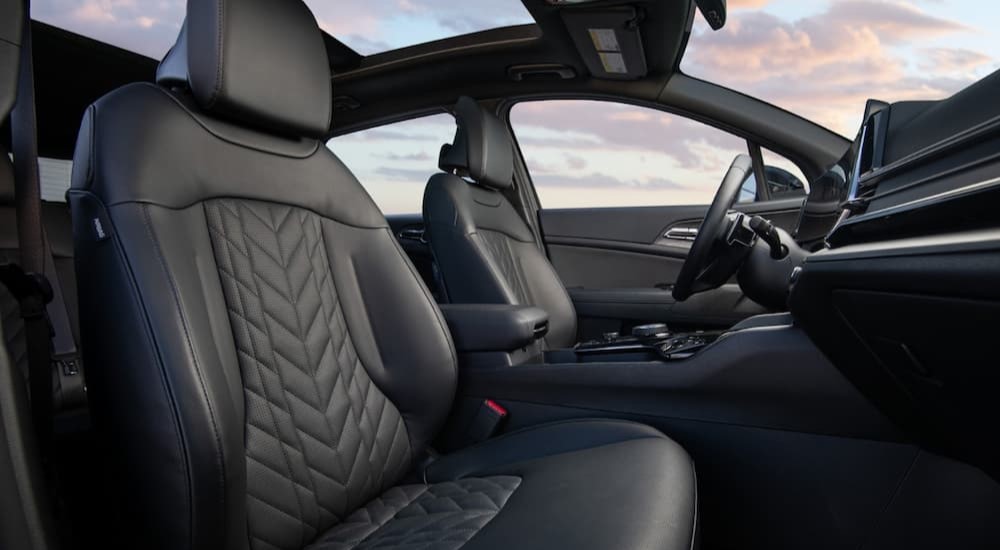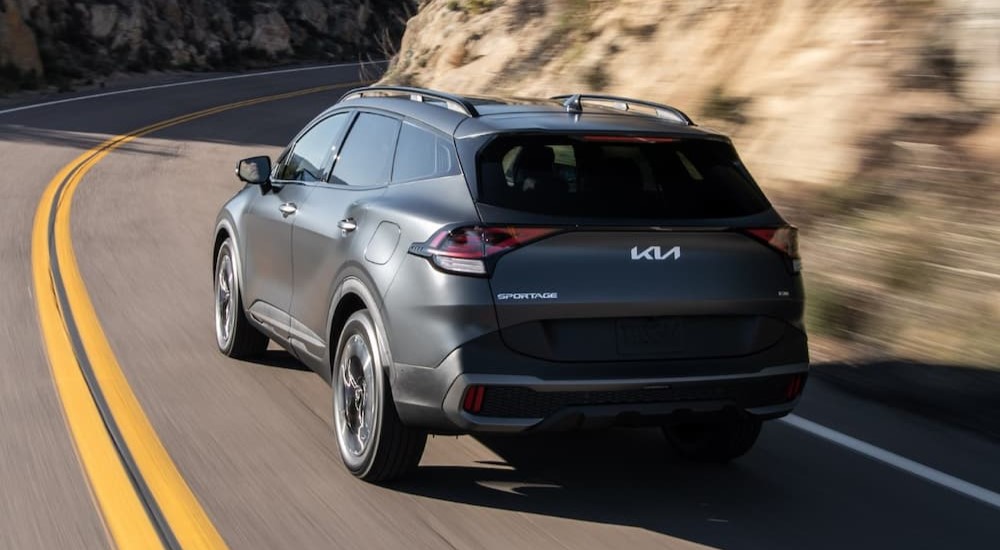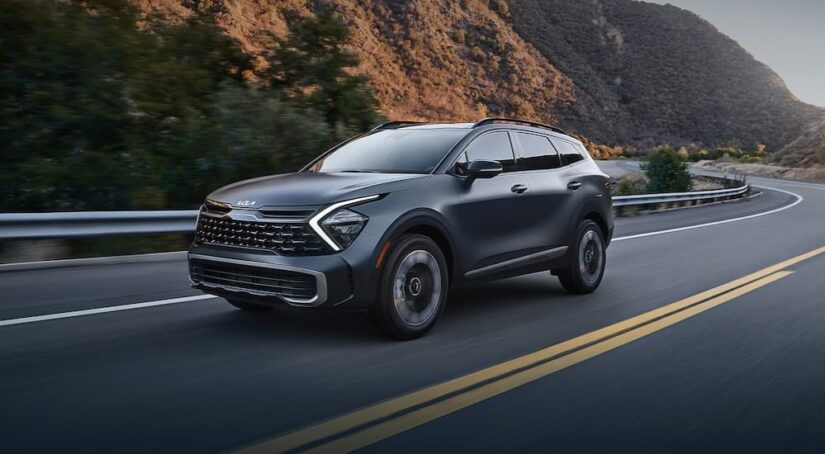The Kia Sportage entered a new generation for the 2023 model year with a bigger body that provides extra cargo volume, enhanced safety tech, and a bold new look that includes a front end that wouldn’t look out of place in a science fiction film. But perhaps the most forward-looking update to the model isn’t its appearance but the addition of two new hybrid powertrains. One is a traditional hybrid electric vehicle (HEV), and the other is a plug-in hybrid electric vehicle (PHEV). The former improves fuel economy significantly, but the latter is an even bigger game-changer.
When you see the Kia Sportage PHEV for sale at a dealership, it might look like the other Sportage models in the lineup from the outside. But underneath the hood, it has a powertrain that can help drivers save money on fuel while producing less air pollution and fewer climate-damaging emissions. On top of that, it’s actually more powerful than the HEV and gas versions of the Sportage. And it has some unique features that can come in handy for drivers of all stripes.
With all of these factors put together, it seems like the Sportage PHEV is a huge step forward for the nameplate. But is it all flash and hype, or is this really a major breakthrough for the SUV? Let’s take a closer look and see how the all-new Sportage PHEV stacks up to other Sportage models.

Fuel Economy
Of course, the hybrid versions of the Sportage have better fuel economy ratings than the standard gasoline version. But just how wide is the gap between the different powertrains? A 2023 Sportage equipped with the base 2.5L gas engine and all-wheel drive will have the highest monthly fuel costs in the lineup, with a fuel economy rating of 9.5 L/100 km. Opting for front-wheel drive instead brings that figure down to 8.4 L/100 km, but you don’t get the extra traction that all-wheel drive provides, which can come in handy on wet highways and gravel roads.
Both hybrid Sportage models come standard with all-wheel drive, but thanks to their efficient powertrains, they get better fuel economy than even the front-wheel drive gas model. The traditional hybrid has a fuel economy rating of 6.2 L/100 km combined. If you look at the 2023 Sportage PHEV’s gasoline-only figure, you’ll find that it’s not quite as low, coming in at 6.7 L/100 km combined. That makes sense when you consider the fact that the larger battery makes the PHEV heavier and that the HEV and PHEV use the same gas engine.
But the 2023 Sportage PHEV is not meant to run on gasoline alone. Charging the battery provides extra power without burning more fossil fuels. When you drive with the battery charged, you can unlock an efficiency rating of 2.8 Le/100 km combined. This is clearly the most efficient by far, with less than half of the energy consumption of the Sportage HEV and less than a third of the gas Sportage’s rating.
Performance
The powertrain in the Sportage PHEV may be more efficient, but does that fuel economy come at the expense of power? Let’s take a look. The base 2023 Sportage is powered by a 2.5L four-cylinder gas engine that produces 187 hp and 178 lb-ft of torque. These figures determine how quickly the SUV can accelerate and how well it performs at high speeds, both of which can be important when driving on the highway. Higher figures mean more power and a better ability to take a thrilling joyride.
Both the HEV and PHEV variations of the 2023 Sportage use a 1.6L turbocharged gas engine. On its own, this engine produces up to 177 hp and 195 lb-ft of torque. That’s already more torque than the base 2.5L engine but a slightly lower amount of horsepower. However, we also have to consider the electric motors. The Sportage HEV has a motor that can produce 59 hp and 195 lb-ft of torque on its own, making for a combined powertrain output of 227 hp and 258 lb-ft of torque. The motor in the PHEV is even more powerful, churning out 90 hp and 224 lb-ft of torque on its own for a combined output of 261 hp and 258 lb-ft of torque when it’s working in concert with the turbocharged engine. Looking at these numbers, the Sportage PHEV is easily the most powerful option in the lineup.
Capability
Because the powertrain has higher stats, you might think that the hybrids also have the highest towing capacity in the lineup. However, it’s a little more complicated than that. The minimum curb weight of the gasoline Sportage is 1,530 kg, while the Sportage HEV weighs 1,693 kg and the Sportage PHEV is 1,910 kg. And since towing can deplete battery power, you have to account for that when setting the maximum safe capacity. With all that in mind, the towing capacity of the gas Sportage is 1,134 kg, while both the HEV and PHEV have a capacity of 907 kg. Unless you have a trailer or boat that takes you right up near the limit of the Sportage’s capacity, this probably won’t affect your life at all. But for those who do need to tow 1,000 kg of weight, this is a point in favour of the base powertrain.

All-Electric Mode
While not everyone needs to tow 1,000 kg around, we all need to pay for fuel in order to drive. But not all fuels are created equally, nor are they priced the same. According to the Government of Canada, it can cost five to ten times less to charge an EV than it does to fuel up a comparable gas-powered vehicle to travel the same distance. Those are some pretty significant savings. On top of that, powering your car with electricity doesn’t release any tailpipe emissions, which is good for the local air quality and the planet as a whole.
While the 2023 Sportage PHEV has a gas engine, its battery and electric motor are powerful enough to drive an estimated 55 km in all-electric mode. With a Level 2 charger (which can be installed at home or found at public charging stations), you can charge the battery back up to full in approximately two hours. If you have a 20 km commute or do a lot of driving around town, you may be able to go for days or weeks at a time without using any gasoline at all. That’s something that no other version of the Sportage can offer.
So, Is the Sportage PHEV All That?
Comparing the PHEV with the other versions of the 2023 Sportage, it’s clear that the plug-in hybrid’s pros massively outweigh its cons. Unless you really need to tow upwards of 1,000 kg, there’s not much that the gas and HEV Sportage models have to offer that the Sportage PHEV doesn’t. On the other hand, the PHEV’s extra power, impressive fuel economy, and electric-only mode are features that none of the other models can equal. Pair all that with the latest generation’s modern styling and tech improvements, and it’s safe to say that the PHEV truly is the best Sportage yet.



